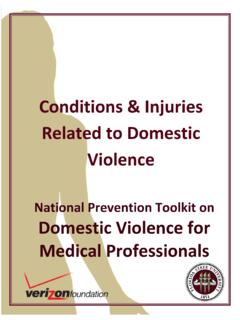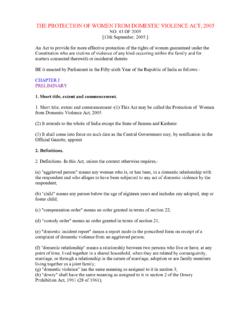Transcription of Telling Domestic Violence FAQ - Telling Amy's Story
1 FREQUENTLY ASKED QUESTIONSD omestic Violence Toolkit // Frequently Asked Questions // 2 FREQUENTLY ASKED QUESTIONSWhat is Domestic Violence ? Domestic Violence is a pattern of behavior in any intimate relationship whereby one partner seeks to gain or maintain power and control over the other. Abuse can be physical, sexual, emotional, economic, and psychological. The abuser takes action or makes threats that influence the other person. This includes any behaviors that frighten, intimidate, terrorize, manipulate, hurt, humiliate, blame, injure, or wound someone. Domestic Violence can happen to anyone of any race, age, sexual orientation, religion, and gender.
2 It can happen with couples who are married, living together, or dating. Domestic Violence affects people of all socioeconomic backgrounds and education levels. (Adapted from National Domestic Violence Hotline)How prevalent is Domestic Violence ?According to a 2008 study by the Centers for Disease Control and Prevention, about of all women in the report that they have experienced Domestic average, more than 3 women are murdered by their husbands or boyfriends in this country every million women have been raped by an intimate partner at some point in their in 3 women worldwide has been beaten, coerced into sex, or otherwise in 5 female high school students reports being physically and/or sexually abused by a dating partner.
3 Abused girls are significantly more likely to get involved in other risky behaviors. They are 4 to 6 times more likely to get pregnant and 8 to 9 times more likely to attempt suicide than their non-abused in 3 teens report knowing a friend or peer who has been hit, punched, slapped, choked, or otherwise physically hurt by his/her Bureau of Justice Statistics (Feb. 2003).Crime Data Brief, Intimate Partner Violence , Extrapolated from the National Violence Against Women Survey (NVAWS) and Census population. Centers for Disease Control and Prevention, National Center for Injury Prevention and Control (2003).
4 Costs of Intimate Partner Violence Against Women in the United States. Atlanta, Silverman, , Raj, A., and Clements, K. (2004). Dating Violence and associated sexual risk and pregnancy among adolescent girls in the United , 114(2): These are findings from a study commissioned by Liz Claiborne Inc. to investigate the level of and attitudes towards dating abuse among American teenagers aged 13 to 18. Teenage Research Unlimited (TRU). (2005). Teen Dating Abuse Survey. Available at Gazmararian, , Petersen, R., Spitz, , Goodwin, , Saltzman, , and Marks, (2000) Violence and reproductive health; current knowledge and future research directions.
5 Maternal and Child Health Journal, 4(2): Violence Community Toolkit // Frequently Asked Questions // 3// FREQUENTLY ASKED QUESTIONS //Where do you go for help?The National Domestic Violence Hotline (NDVH) provides anonymous and confidential help. The NDVH is a nonprofit organization that provides crisis intervention, information, and referrals to victims of Domestic Violence , perpetrators, friends, and families. 1-800-799-7233 (SAFE)Hotline Services:Crisis intervention, safety planning, information about Domestic Violence , and referrals to local service providersDirect connection to Domestic Violence resources available in the caller s area provided by a Hotline advocateAssistance in both English and Spanish with Hotline advocates who have access to more than 170 different languages through interpreter servicesAssistance through e-mail Informational materials on such topics as Domestic Violence , sexual assault, battering intervention and prevention programs, working through the criminal justice system.
6 And related issues What will a Domestic Violence advocate do?Listen Support your decisions Not blame you Help in a way that is best for you How can a Domestic Violence advocate help?Create a safety plan Navigate law enforcement Arrange for shelter Get information and referrals to local resources Advocate for you through the judicial system Set up regular counseling Connect with a support group Why do victims stay?LoveAbusers are not hurtful all the time. Many abusers have a likable and loving side. Many victims think that they can change the abuser s behavior. FearMany abusers threaten to hurt or kill themselves if their victim decides to leave.
7 Abusers often threaten that the Violence will get worse if the partner decides to leave. DoubtIt s not always easy for a victim to admit that the relationship is abusive. If the victim s partner is especially popular at school or in the community, the victim may be concerned about losing social status. EmbarrassmentVictims can be afraid of an I told you so response from those who have tried to help in the for ChangeVictims often believe that the abuser will return to the person he was at the beginning of the relationship the person she fell in love a tactic of the abuse, the abuser is likely to have made it difficult for the victim to access resources and supportive DenialAbusers often have a public face that is charming and charismatic.
8 It is difficult for those who only know that side to believe that abuse is taking ExpectationsThe victim may see ending the relationship as a failure and may also fear social stigma. The victim may not fit stereotypes about victims of Domestic of ResourcesIt may be difficult or impossible for the victim to contact supportive people, and she may not have money or any way to find Violence Community Toolkit // Frequently Asked Questions // 4// FREQUENTLY ASKED QUESTIONS //Economic AutonomyThe number one indicator that a victim will be able to leave is economic stability outside of the victim may believe that it is better for a child if the parents are together.
9 The victim may not want to disrupt childcare or schooling arrangements. (Adapted from Centre County Women s Resource Center)What can you say?I believe you. You are not alone. No one deserves to be abused. It can be difficult to know what to do. It can feel overwhelming at times. It s ok to still love him/her but not like what s am concerned for your safety. Leaving can be a very dangerous time. There are options available. Abuse is often about power and control. I ve noticed you ve been late, absent, tired, different lately, I m know your situation best. It s important for you to make the decision that is best for local Domestic Violence program may be able to help with a safety local Domestic Violence program may be able to explore options with helpful things to doListen Respect privacy and confidentiality Respect her choices Encourage her to seek professional resources Validate feelings (Centre County Women s Resource Center and National Domestic Violence Hotline)What are some signs of Domestic Violence ?
10 Look forPhysical signs of injury Signs of anxiety and fear Emotional distress Isolation Change in appearance and self-esteem Restricted transportation Clothing that is inappropriate for the season Attempts to hide activities or interactions from partner Minimization and denial of harassment or injuries (Centre County Women s Resource Center)What does an abuser look like?Abusers come from all walks of life. Much like victims , you cannot identify an abuser by where he lives, or what he does for a living. Abusers are unemployed workers, farmers, computer experts, car salesmen, university professors, truck drivers, psychiatrists, and teachers everyone.






